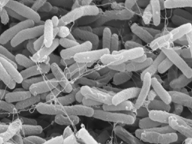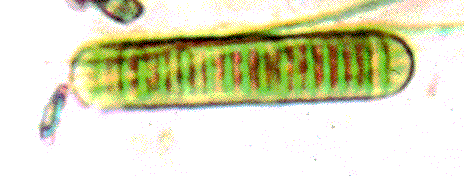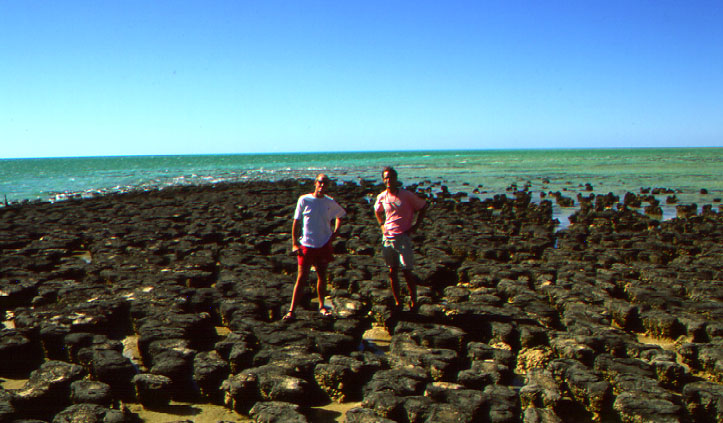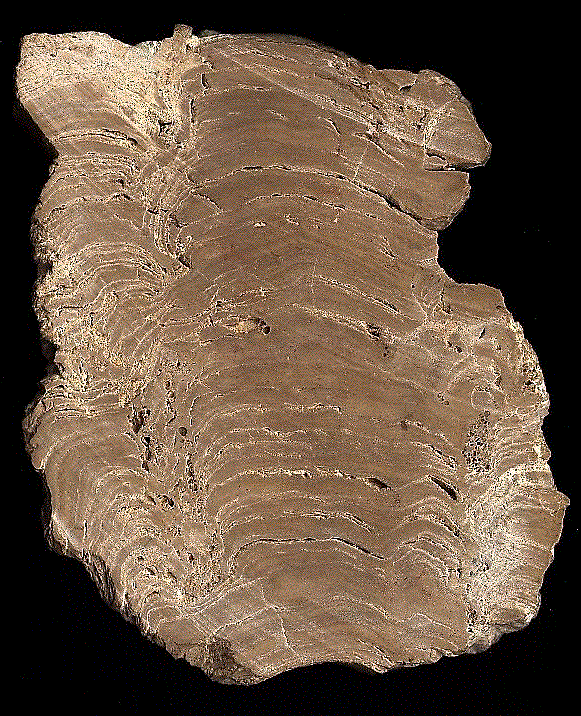

Stromatolites
Stromatolites are layered mounds, columns, and sheet-like sedimentary rocks. They were
originally formed by the growth of layer upon layer of cyanobacteria, a
single-celled photosynthesizing microbe that lives today in a wide range of environments
ranging from the shallow shelf to lakes, rivers, and even soils. Cyanobacteria are
prokaryotic cells (the simplest form of modern carbon-based life) in that they lack a
DNA-packaging nucleus. Bacteria, including the photosynthetic cyanobacteria, were
the only form of life on Earth for the first 2 billion years that life existed on
Earth.
 |
 |
| SEM photo of E-Coli, a modern bacterium that lives in the human intestine | Photomicrograph of Oscillatoria, a modern blue-green alga |
 |
Drawing of columnar stromatolites like the ones shown in the picture below. Shows internal layering and close-up of lamina structure. Surface is covered by a felt of cyanobacterial filaments that trap sediment grains that are washed across the mat surface. Abundant sediment supply produces granular laminae, low sediment supply produces layers rich in organic matter (green in drawing). |

This picture shows modern stromatolites (columns and mounds) in Shark
Bay (Western Australia). Although algal mats and films are common in many modern
sedimentary environments, they are rarely recognised because of continual destruction
(grazing) by snails, worms, and other animals. Today, only in places where metazoan
grazing is restricted due to extreme conditions (high salinity, too hot, etc.; basically
only cyanobacteria can survive) can stromatolite domes like these form in ways that are
reminiscent of the Precambrian (when metazoan grazing was absent because metazoans had not
evolved yet). The Precambrian was the age of microbes, macroscopically expressed in
colonial structures that we call stromatolites.

In the rock record, stromatolites can be recognized by characteristic laminar
structures, such as those seen in the picture above. This is basically the cross
section of a columnar stromatolite as seen in the Shark Bay picture.
Although simple, cyanobacteria were ultimately responsible for one of the most important
"global changes" that the Earth has undergone. Being photosynthetic, cyanobacteria produce oxygen as a by-product. Photosynthesis is the only major source of
free oxygen gas in the atmosphere. As stromatolites became more
common 2.5 billion years ago, they gradually changed the Earth's atmosphere from a carbon
dioxide-rich mixture to the present-day oxygen-rich atmosphere. This
major change paved the way for the next evolutionary step, the appearance of life based on
the eukaryotic cell (cell with a nucleus).